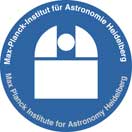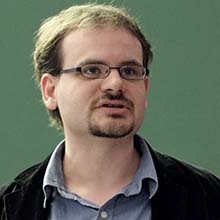Related Research Articles

Edwin Powell Hubble was an American astronomer. He played a crucial role in establishing the fields of extragalactic astronomy and observational cosmology.

A galaxy is a system of stars, stellar remnants, interstellar gas, dust, and dark matter bound together by gravity. The word is derived from the Greek galaxias (γαλαξίας), literally 'milky', a reference to the Milky Way galaxy that contains the Solar System. Galaxies, averaging an estimated 100 million stars, range in size from dwarfs with less than a hundred million stars, to the largest galaxies known – supergiants with one hundred trillion stars, each orbiting its galaxy's center of mass. Most of the mass in a typical galaxy is in the form of dark matter, with only a few percent of that mass visible in the form of stars and nebulae. Supermassive black holes are a common feature at the centres of galaxies.

Astronomy is a natural science that studies celestial objects and phenomena. It uses mathematics, physics, and chemistry in order to explain their origin and evolution. Objects of interest include planets, moons, stars, nebulae, galaxies, meteoroids, asteroids, and comets. Relevant phenomena include supernova explosions, gamma ray bursts, quasars, blazars, pulsars, and cosmic microwave background radiation. More generally, astronomy studies everything that originates beyond Earth's atmosphere. Cosmology is a branch of astronomy that studies the universe as a whole.

Sandra Moore Faber is an American astrophysicist known for her research on the evolution of galaxies. She is the University Professor of Astronomy and Astrophysics at the University of California, Santa Cruz, and works at the Lick Observatory. She has made discoveries linking the brightness of galaxies to the speed of stars within them and was the co-discoverer of the Faber–Jackson relation. Faber was also instrumental in designing the Keck telescopes in Hawaii.

Astrophysics is a science that employs the methods and principles of physics and chemistry in the study of astronomical objects and phenomena. As one of the founders of the discipline, James Keeler, said, Astrophysics "seeks to ascertain the nature of the heavenly bodies, rather than their positions or motions in space–what they are, rather than where they are." Among the subjects studied are the Sun, other stars, galaxies, extrasolar planets, the interstellar medium and the cosmic microwave background. Emissions from these objects are examined across all parts of the electromagnetic spectrum, and the properties examined include luminosity, density, temperature, and chemical composition. Because astrophysics is a very broad subject, astrophysicists apply concepts and methods from many disciplines of physics, including classical mechanics, electromagnetism, statistical mechanics, thermodynamics, quantum mechanics, relativity, nuclear and particle physics, and atomic and molecular physics.

Big History is an academic discipline which examines history from the Big Bang to the present. Big History resists specialization, and searches for universal patterns or trends. It examines long time frames using a multidisciplinary approach based on combining numerous disciplines from science and the humanities, and explores human existence in the context of this bigger picture. It integrates studies of the cosmos, Earth, life, and humanity using empirical evidence to explore cause-and-effect relations, and is taught at universities and primary and secondary schools often using web-based interactive presentations.

The Max-Planck-Institut für Astronomie is a research institute of the Max Planck Society (MPG). It is located in Heidelberg, Baden-Württemberg, Germany near the top of the Königstuhl, adjacent to the historic Landessternwarte Heidelberg-Königstuhl astronomical observatory. The institute primarily conducts basic research in the natural sciences in the field of astronomy.

Bryan Malcolm Gaensler is an Australian astronomer based at the University of California, Santa Cruz. He studies magnetars, supernova remnants, and magnetic fields. In 2014, he was appointed as Director of the Dunlap Institute for Astronomy & Astrophysics at the University of Toronto, after James R. Graham's departure. He was the co-chair of the Canadian 2020 Long Range Plan Committee with Pauline Barmby. In 2023, he was appointed as Dean of Physical and Biological Sciences at UC Santa Cruz.

The following outline is provided as an overview of and topical guide to astronomy:
Amy J. Barger is an American astronomer and Henrietta Leavitt Professor of Astronomy at the University of Wisconsin–Madison. She is considered a pioneer in combining data from multiple telescopes to monitor multiple wavelengths and in discovering distant galaxies and supermassive black holes, which are outside of the visible spectrum. Barger is an active member of the International Astronomical Union.

Abraham "Avi" Loeb is an Israeli-American theoretical physicist who works on astrophysics and cosmology. Loeb is the Frank B. Baird Jr. Professor of Science at Harvard University, where since 2007 he has been Director of the Institute for Theory and Computation at the Center for Astrophysics. He chaired the Department of Astronomy from 2011–2020, and founded the Black Hole Initiative in 2016.
Leon P. Van Speybroeck was an American astronomer who served as Telescope Scientist for the Chandra X-Ray Observatory which was launched into space aboard the Space Shuttle Columbia in 1999. Speybroek designed the mirrors that made possible its spectacular X-ray images of nearby and remote celestial objects, including comets, exploding stars, jets of gas spewing from nearby black holes, and powerful quasars more than 10 billion light years from Earth. The data from Chandra prompted new discoveries about the evolution of stars and galaxies, the nature of the black holes, dark matter, and the shape and dimensions of the universe.
Caleb Asa Scharf is a British-American astronomer and popular science author. He is currently the senior scientist for astrobiology at the NASA Ames Research Center in Mountain View, California. He formerly served as the director of the multidisciplinary Columbia Astrobiology Center at Columbia University, New York.

Christopher J. Conselice is an astrophysicist who is Professor of Extragalactic Astronomy at the University of Manchester.

The George Darwin Lectureship is an award granted by the Royal Astronomical Society to a 'distinguished and eloquent speaker' on the subject of Astronomy including astrochemistry, astrobiology and astroparticle physics. The award is named after the astronomer George Darwin and has been given annually since 1984. The speaker may be based in the UK or overseas.
Christopher David Impey is a British astronomer, educator, and author. He has been a faculty member at the University of Arizona since 1986. Impey has done research on observational cosmology, in particular low surface brightness galaxies, the intergalactic medium, and surveys of active galaxies and quasars. As an educator, he has pioneered the use of instructional technology for teaching science to undergraduate non-science majors. He has written many technical articles and a series of popular science books including The Living Cosmos, How It Began, How It Ends: From You to the Universe, Dreams of Other Worlds, and Humble Before the Void. He served as Vice-President of the American Astronomical Society, he is a Fellow of the American Association for the Advancement of Science, and a Howard Hughes Medical Institute Professor. He serves on the Advisory Council of METI.
Alice Eve Shapley is a professor at the University of California, Los Angeles (UCLA) in the Department of Physics and Astronomy. She was one of the discoverers of the spiral galaxy BX442. Through her time at University of California, Los Angeles (UCLA) she has taught Nature of the Universe, Black Holes and Cosmic Catastrophes, Cosmology: Our Changing Concepts of the Universe, Galaxies, Scientific Writing, AGNs, Galaxies, *and* Writing, and The Formation and Evolution of Galaxies and the IGM. Shapley has committed herself too over a two decades of research and publication in the interest of physics and astronomy.
G. Mark Voit is an American physicist and professor in the Department of Physics and Astronomy at Michigan State University. His most cited solely-authored paper is "Tracing Cosmic Evolution with Clusters of Galaxies", in Reviews of Modern Physics, at Michigan State University. He is an Elected Fellow of the American Association for the Advancement of Science. His research involves theoretical investigations of clusters of galaxies, galaxy evolution, and the role of supermassive black holes in galaxy evolution. Voit is an expert in the physics of astrophysical gas and dust.

Anne L. Kinney is an American space scientist and educator. Kinney is currently the Deputy Center Director at NASA Goddard Space Flight Center. Previously, she held positions as the head of the Directorate for Mathematical and Physical Sciences (MPS) for the National Science Foundation (NSF), the Chief Scientist of the W.M. Keck Observatory, Director of the Solar System Exploration Division at NASA Goddard Space Flight Center, Director of the Origins Program at NASA Jet Propulsion Laboratory, and Director of the Universe Division at NASA Headquarters. She earned a bachelor's degree in astronomy and physics from the University of Wisconsin-Madison and a doctorate in astrophysics from New York University, and has published more than 80 papers on extragalactic astronomy. She was an instrument scientist for the Faint Object Spectrograph that flew on the Hubble Space Telescope.

Brad Gibson is an Australian-Canadian astrophysicist. He is the Head of the Department of Physics & Mathematics, and Director of the E.A. Milne Centre for Astrophysics, at the University of Hull. He is known for identifying the regions of the Galaxy most likely to harbor complex biological life, designing and constructing the first operational liquid mirror telescope observatory, and using supernovae as cosmological probes, the latter for which led to the 2009 Gruber Prize in Cosmology. A passionate advocate for Widening Participation, Gibson delivers more than 100 presentations annually to schools and the general public; his Changing Face of Physics campaign has been highlighted as Good Practice by the UK Equality Challenge Unit.
References
- ↑ Science, p1010, November 30, 2018
- ↑ "Inside Cool Interstellar Clouds," Nature, p311, October 6, 1972
- ↑ "Gaseous Nebulas", E. Chaisson, Scientific American, pp164-180, December 1978
- ↑ ”Black Hole Reportedly Detected at Core of the Milky Way Galaxy,” W. Sullivan, New York Times, p24, March 15, 1979
- ↑ Harvard Astronomer Announces Find of Possible Black Hole at Milky Way Galaxy's Core," The Harvard Crimson, March 16, 1979
- ↑ Big History and the Future of Humanity, Spier, F., Wiley-Blackwell, London, 2011
- ↑ ”Energy Flows in Low-Entropy Complex Systems,” E. Chaisson, Entropy, v 17, pp8007-8018, 2015
- ↑ ”The Other Global Warming,” B. Venkataraman, Boston Sunday Globe, page 1, January 25, 2009
- ↑ ”The Heat to come . . .” E. Chaisson, New Scientist, pp24-25, April 4, 2009
- ↑ ”How clean is green?” A. Ananthaswamy, New Scientist, pp35-38, January 28, 2012
- ↑ ”The Ascent of Life,” M. Chorost, New Scientist, pp35-37, January 21, 2012
- ↑ "A Unifying Concept for Astrobiology," E. Chaisson, International Journal of Astrobiology, v 2, p 91, 2003.
- ↑ ”Unnecessary Complexity,” D. McShea, Science, v 342, pp1319-1320, 2013
- ↑ "Rhythm of the Cosmos: Finding Unity among the Natural Sciences", E. Chaisson, Tufts Magazine, pp 16-22, Spring, 2001.
- ↑ The 13th Labor: Improving Science Education: A collection of essays from a workshop at the American Academy of Arts & Sciences, T-C. Kim and E. Chaisson (eds.), Gordon&Breach Publishers, 1999
- ↑ Astronomy Today, Chaisson, E. and S. McMillan, Pearson, 9 editions, 1993-2018
- ↑ "Military Planners View the Shuttle As Way to Open Space for Warfare," Lyons, R., New York Times, p34, March 29, 1981
- ↑ "Eric J. - Chaisson // Institute for Advanced Study // University of Notre Dame".
- ↑ "Bok Prize". Department of Astronomy. Harvard University . Retrieved 2016-03-06.
- ↑ Harvard Gazette, November 10, 1979
- ↑ "Heaven comes down to earth with Annapolis man in the classroom," Harper, S., The Sunday Capital, April 2, 1989
- ↑ "Early Results from the Hubble Space Telescope," Chaisson, E., Scientific American, pp44-52, June 1992
- ↑ "Chaisson and Kitchener Honored,"Physics Today, p28, December 1995
- ↑ New York Times Book Review, C. Raymo, May 29, 1994
- ↑ Foundation for the Future, 2007